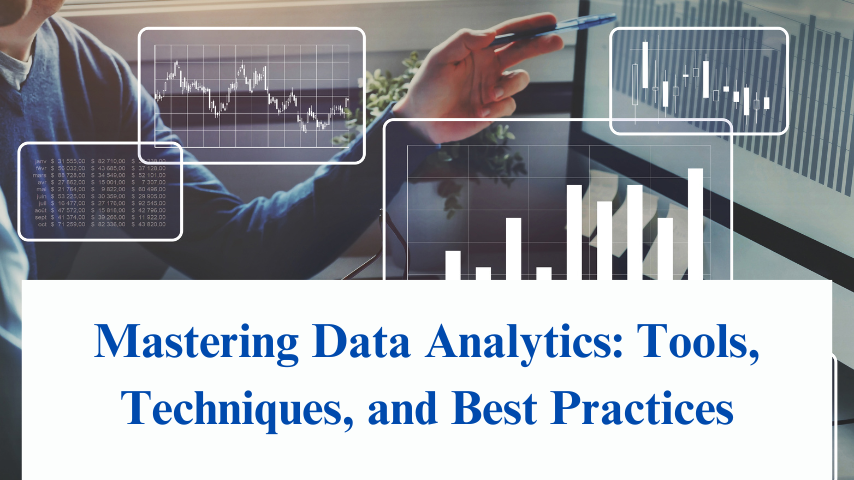
Mastering Data Analytics: Tools, Techniques, and Best Practices
In today’s data-driven world, mastering the art of data analytics is more critical than ever. From uncovering valuable insights to making informed decisions, the journey begins with understanding the tools, techniques, and best practices that underpin this discipline.
Data Analytics Tools
In the vast landscape of data analytics, selecting the right tools is akin to choosing the right instrument for a musician. It forms the foundation upon which the symphony of insights is created. To embark on the journey of mastering data analytics, one must first acquaint themselves with the diverse tools available.From the versatility of Python to the analytical prowess of R, the accessibility of Tableau to the familiarity of Excel, data analytics tools come in various shapes and sizes, each catering to specific needs and preferences. Python and R, for instance, are favored for their robust statistical and machine learning libraries, while Tableau and Excel excel in data visualization and business intelligence. Selecting the appropriate tool depends on factors such as the nature of the data, the analytical goals, and the individual’s proficiency with the tool.
Data Collection and Preparation
Data analytics, much like building a strong house, starts with a sturdy foundation. In this case, the foundation consists of the data itself, making data collection and preparation a pivotal aspect of mastering the field. Data collection encompasses the art of gathering information from various sources. This can range from structured data within databases to unstructured data from social media, sensors, or text documents. Successful collection hinges on understanding the sources, defining data requirements, and implementing effective data retrieval methods. Once data is collected, the real work begins with data preparation. This involves cleaning, transforming, and organizing the raw data into a structured format suitable for analysis. Raw data is often messy, containing missing values, outliers, and inconsistencies that need to be addressed. Data preprocessing techniques, including data imputation, standardization, and feature engineering, are essential to refine the data for meaningful analysis. Data quality is paramount in the preparation phase. Poorly prepared data can lead to inaccurate or biased insights, undermining the entire analytical process.
Data Analysis Techniques
With a well-prepared dataset in hand, you’re ready to dive into the heart of data analytics: data analysis techniques. These techniques are the tools that unlock the hidden stories within your data, providing valuable insights, uncovering patterns, and guiding decision-making.
Data analysis can be broadly categorized into four main types:
- Descriptive Analytics: This stage involves summarizing and describing the historical data, creating a foundation of understanding. It often includes basic statistical measures, data visualizations, and dashboards.
- Diagnostic Analytics: Going a step further, diagnostic analytics seeks to understand the reasons behind past events. It involves identifying trends, correlations, and anomalies to pinpoint the root causes of specific outcomes.
- Predictive Analytics: Predictive analytics harnesses statistical and machine learning techniques to forecast future trends and outcomes. It’s invaluable for tasks such as sales forecasting, customer churn prediction, and risk assessment.
- Prescriptive Analytics: The pinnacle of data analysis, prescriptive analytics not only predicts future outcomes but also recommends actions to optimize those outcomes. It’s particularly powerful for decision support, offering actionable insights to address business challenges.
Best Practices for Data Visualization
Data visualization is the art of turning complex data into clear, comprehensible visual representations. It plays a pivotal role in data analytics, as it’s often the means by which insights are communicated to stakeholders. Effective data visualization can enhance understanding and decision-making, making it a critical component of mastering data analytics.
- Appropriate Chart Types: Choose chart types that best represent the data and the insights you want to convey. Bar charts, line graphs, scatter plots, and heatmaps each have their own strengths.
- Color and Contrast: Utilize color judiciously to highlight important data points and create visual hierarchy. Ensure that colors are easily distinguishable, especially for colorblind individuals.
- Storytelling: Craft a narrative with your visualizations. Provide context, tell a story, and guide the viewer through the data, helping them understand the significance of the findings.
- Interactivity: Use interactive elements when appropriate to allow users to explore the data on their own. Interactive dashboards and tools can enhance engagement and understanding.
- Consistency: Maintain consistency in your visualizations. Use the same color schemes, fonts, and terminology throughout your reports and dashboards for a professional and cohesive look.
By mastering these best practices, you’ll not only create more compelling and informative visualizations but also improve your ability to convey insights effectively, which is essential in the world of data analytics.
Data Analytics in Business
Data analytics is not just a theoretical concept—it’s a practical tool for driving success in various industries. In this section, we delve into the real-world applications of data analytics in businesses and showcase its transformative power. From retail to healthcare, finance to marketing, data analytics is being used to optimize operations, reduce costs, and enhance decision-making. Case studies and examples from different sectors illustrate how data analytics can:
- Optimize Marketing Strategies: Explore how businesses use customer data and market analytics to refine marketing campaigns, target specific demographics, and maximize ROI.
- Enhance Customer Experience: Discuss how data analytics can improve customer service and personalize user experiences through recommendation engines and customer feedback analysis.
- Streamline Supply Chain Management: Highlight how companies leverage analytics to optimize inventory management, reduce waste, and increase supply chain efficiency.
- Detect Fraud and Security Threats: Examine the role of data analytics in identifying fraudulent activities, cybersecurity threats, and risk management.
- Improve Healthcare Outcomes: Showcase how healthcare organizations utilize patient data and clinical analytics to enhance diagnoses, treatment plans, and healthcare delivery.
- Financial Forecasting and Risk Management: Explain how financial institutions employ predictive analytics to make informed investment decisions and manage risks effectively.
Conclusion
In conclusion, mastering data analytics is an exciting journey, one that requires a deep understanding of tools, techniques, and best practices. Data analytics is not merely a technical skill; it’s a discipline that empowers individuals and organizations to make data-driven decisions, unlock valuable insights, and drive innovation. Whether you’re a business professional, data scientist, or aspiring analyst, the principles outlined in this article can serve as a roadmap to your success. For those looking to embark on this journey, seeking quality education is crucial. Consider enrolling in a reputable institute which provides Data Analytics Training Institute in Delhi, Mumbai, Bangalore, Chennai, Guwahati, , Shimla, etc. Remember, the field of data analytics is ever-evolving, and your commitment to learning and continuous improvement will be the key to your long-term success in this exciting and impactful discipline.



